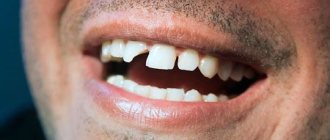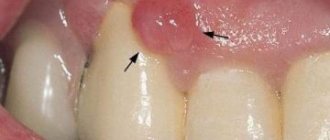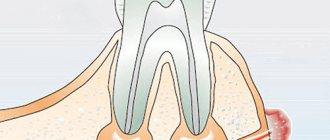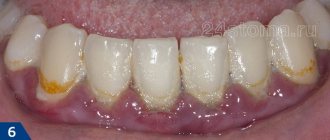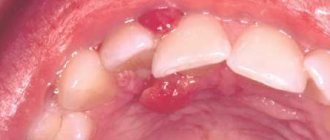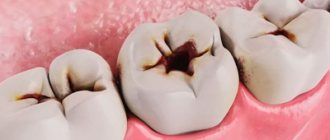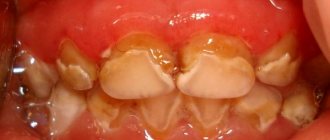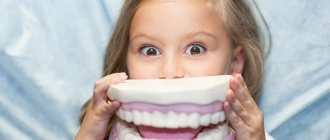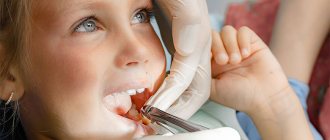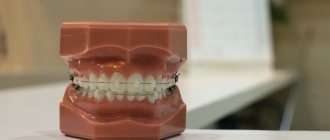The soft tissues of the oral cavity have an increased susceptibility to all kinds of infections. Bacteria can actively multiply as a result of leftover food and drinks between the teeth, with improper oral hygiene, and under the influence of external irritants.
Manifesting themselves as various neoplasms, pathological processes can lead to serious complications. A lump on a child’s gum should alert parents, because not everyone knows how this can turn out.
Causes of thrush in a newborn
There is only one reason that can provoke candidal stomatitis in babies in the first months of life - weak functioning of the immune system as a result of the influence of unfavorable factors.
Conventionally, unfavorable factors can be divided into two groups: internal, associated with the functioning of the body and the functioning of organs, and external.
Internal factors:
- deep prematurity (birth a month or more before the due date);
- low birth weight (less than 2500 g; and less than 1700 g for a child born during a multiple pregnancy);
- congenital defects and pathologies of the formation of internal organs;
- insufficient supply of nutrients and vitamins (occurs when the mother’s diet is poor, if the child is on breastfeeding);
- anemia (low hemoglobin levels as a result of iron deficiency);
- intestinal dysbiosis;
- disturbances in the functioning of the endocrine system;
- rickets;
- history of infectious diseases.
External factors:
- Injury to the oral cavity . Abrasions and cracks in the oral mucosa are an excellent environment for fungi to settle and actively reproduce.
- Antibiotic therapy . It often happens that in the first days of a child’s life it is necessary to give him strong antibiotics (for example, when a child is born with pneumonia and is placed in the intensive care unit immediately after birth). Antibiotics of various groups have a detrimental effect not only on pathogenic bacteria, but also on beneficial microflora, destroying and destroying them. As a result, the newborn develops dysbiosis.
- Refusal of breastfeeding and transfer of the baby to artificial formula . Even the most expensive milk substitutes contain a lot of sugar, which is added to maximize the taste of the product. The acidity of the oral cavity increases and creates a breeding ground for fungal growth.
- Candidiasis in the mother in the last stages of pregnancy . If a woman does not have time to cure thrush before giving birth, the likelihood of infection of the child during passage through the birth canal becomes very high.
- Insufficient hygiene of the newborn. This includes any factors that can provoke the colonization of mucous membranes by harmful organisms: dirty rattles, unboiled nipples and bottles, poor skin care for the baby, etc.
Possible complications
Taking good care of your child's oral cavity will help avoid serious complications. Parents need to remember that not every pimple or ulcer signals a serious pathology. The main reason for their appearance is damage to the oral mucosa. However, you should be wary of such things as frequent and painful inflammatory processes that bother the baby and provoke a rise in temperature. In these cases, stomatitis is a symptom:
- gingivitis;
- diphtheria;
- tonsillitis;
- measles;
- tuberculosis;
- and etc.
Timely diagnosis and treatment minimize the negative consequences of the above diseases. So, complications of measles, for example, are pneumonia, otitis media and laryngitis, and tonsillitis – arthritis, pyelonephritis, rheumatism.
How to determine if a newborn has candidiasis
This will not be difficult, since the hallmark of thrush in the mouth is the appearance of a white coating that can cover the tongue, gums, inner surface of the cheeks, palate, tonsils, and tonsils.
Thrush spreads to the back of the pharynx in the absence of the necessary therapeutic measures. In very rare cases, the fungus can affect the baby's esophagus and even intestines.
A specific coating, similar to semolina grains (in advanced cases, it can resemble particles of cottage cheese) is the primary sign of thrush.
There are also secondary symptoms that usually appear simultaneously with the main symptom of the disease:
- poor appetite (refusal to breastfeed or bottle);
- crying during feeding;
- sleep disturbance at night;
- general malaise;
- moodiness and irritability;
- redness of the mucous membranes of the oral cavity, wounds and ulcers;
- an increase in temperature to 37-38 degrees (in cases where a bacterial infection is associated with a fungal infection).
The appearance of such symptoms is a reason to call your local pediatrician or consult with a pediatrician online.
Local diseases
The cause of white rashes is stomatitis, which manifests itself in different forms:
- Aphthous - the cause of its appearance has not been identified; it occurs in acute, chronic and recurrent forms. The disease is characterized by the appearance of many aphthae (ulcers) of irregular shape, leading to difficulties in eating. Healing is long and sometimes lasts several months.
- Candidiasis - most often found in newborns. The white pimples in the mouth gradually merge, and the entire cavity becomes covered with a whitish coating.
- Herpetic - unlike previous forms, the sores are pinkish or red in color and have a watery structure. In addition to the oral cavity, the lips are also affected. It occurs in children from one and a half to three years old. The mild form can be treated at home, while the severe form can be treated in a hospital.
- Allergic – provoked by allergens: plant pollen, household dust, animal hair, etc. By removing the source of the allergy, stomatitis stops.
- Bacterial – develops due to the penetration of pathogenic microflora (staphylococci, streptococci) into existing wounds in the oral cavity.
How to distinguish thrush from the consequences of regurgitation
Some parents (especially if the child is the first-born) mistakenly mistake the plaque for the remains of curdled milk after the baby has burped. Indeed, it can be very difficult to visually determine the nature of the contents of the oral cavity.
To understand what exactly caused the symptom, you can do a small test. You need to moisten a piece of clean cloth with boiled water or chamomile decoction and try to remove the plaque.
If this is the remains of milk after regurgitation, then the baby’s mouth will be easily cleaned, and all the contents will end up on the tissue. If you have thrush, it is not so easy to remove plaque (after the procedure, irritated areas will remain at the site of inflammation).
White pimples on the gums are not a pathology
Only a pediatric dentist can convince worried parents that there is no need to worry and that white spots in the child’s mouth are not an anomaly. Below we consider phenomena that are not dangerous to children's health:
- Bohn's nodules are small whitish formations that appear on the upper or lower gums. They are cysts in nature, but they do not pose a danger to the baby’s health. Over time, the nodules will go away on their own. In some cases, parents may mistake such formations for teeth that are beginning to erupt.
- Epstein's pearls look like small spots and are often located on the palate. This phenomenon also cannot be treated, since it does not pose a threat. The pearl oyster will go away on its own.
Whitish spots may be the remains of food that the baby consumed and then regurgitated. They should go away on their own within a short period of time because they are washed away by saliva. If the plaque does not go away for a long time, this is a reason to contact an experienced specialist.
Treatment
Some people mistakenly believe that candidiasis needs to be treated with antibiotics - this is not true at all. Antibiotics are effective only against bacterial organisms, and thrush is a fungal infection.
The disease is treated with local therapy aimed at destroying pathogens and producing a bactericidal and disinfectant effect.
Medication method
"Stomatidin" . Quickly copes with mushrooms that have a yeast-like structure. You need to use the product to treat the affected areas 2 times a day.
"Candide" (solution) . The active substance destroys the membrane of fungi, completely destroying them and suppressing the growth of pathogenic bacteria. The course of treatment is at least 10 days. It is important to continue therapy for the recommended period, even if visible signs of the disease have disappeared.
Doctor's advice
If you observe hygiene products for your child, you should use baby products – soap, foam, etc. Regular soap is too aggressive - it easily washes away representatives of normal microflora from the baby’s skin, and the resulting niche can be occupied by a fungus. It is easy to transfer it from the skin to the oral mucosa - any household item, the hands of mother and child, things can contribute to this. The child should not be sterile, so there is no need to get carried away with the excessive use of even children's cosmetics.
Victoria Druzhikina Neurologist, Therapist
"Diflucan". The drug can be used in newborns starting from the 11th day of life. Until the age of 1 month, the product is used only for intravenous infusion. This measure is usually a last resort and is used only when necessary.
"Nystatin" . Destroys fungal infections, relieves inflammation and does not irritate the baby's mucous membranes. The duration of use of the medicine is 7-10 days (at a dosage of 1 drop on each side). The drug is applied to a cotton swab, after which the inner surface of the cheeks is treated.
Brilliant green (green) . The use of brilliant green is very effective in the treatment of thrush in infants. A small amount of brilliant green should be applied to a cotton pad and thoroughly treated the inflamed areas. Usually two procedures are enough to completely solve the problem.
If you cannot treat the oral cavity with cotton swabs, you can apply brilliant green to the pacifier or pacifier. To achieve a therapeutic effect, 1 minute of active sucking is enough.
The safest drug is chamomile. Treatment with chlorhexidine bigluconate solution 0.05% is possible. To do this, moisten the cotton wool, wring it out and carefully wipe the affected area. Make sure that the drug does not flow from the cotton wool into the child’s throat. You can process 2-3 times per day. If the place is hard to reach, then instead of the mucous membranes of the mouth, you can wipe the pacifier before giving it to the child. 2-3 times a day. Peroxide solution should not be used to avoid burns.
Victoria Druzhikina
Neurologist, Therapist
Traditional methods
The following folk remedies are effective in treating oral thrush:
- Soda . After feeding, treat the baby's mouth with a soda solution (if the baby is bottle-fed, do the same procedure with the nipples).
- Tincture of calendula. Suitable for slow douching or local surface treatment.
- Chamomile decoction . Use a moistened cotton swab to treat the oral cavity several times a day (5-6 times).
What symptoms does it accompany?
Symptoms of a tumor on the gums in children differ and depend on the stage of development of the disease:
- at the first stage, the abscess proceeds unnoticed, there may be an itching or aching sensation inside the gums;
- then the tissue swells and redness appears, and pain occurs upon contact with the affected area;
- the swelling turns into a noticeable red bump that hurts;
- the ball with pus grows and changes its color to white (this indicates the maturation of the contents), the abscess is soft to the touch;
- the pain increases, the patient has the impression that the entire jaw hurts;
- temperature can reach critical levels (39-40 C);
- the abscess opens, white pus flows out of it, after which the temperature returns to normal.
The child's behavior also changes - he becomes capricious, irritable, and sleeps poorly. The baby often cries, screams, and refuses to eat. The characteristic appearance of a purulent sac in the mouth is shown in the photo below.
Opening an abscess does not guarantee complete elimination of the problem (we recommend reading:
decreased immunity or infection.
The ball of pus is not always able to open on its own; the help of a dentist is often required. Only a specialist can properly eliminate an abscess; no traditional methods can replace a qualified dentist.
Prevention of thrush in newborns
To prevent thrush from returning, as well as for preventive purposes, you should follow simple rules:
- boil bottles, nipples and pacifiers if the child eats formula after each feeding;
- cleanse your baby’s skin daily using hygiene procedures;
- wash your hands before playing or interacting with the child, before feeding;
- pay enough attention to mother’s breast hygiene if the newborn receives mother’s milk as food;
- after feeding, clean the mouth with water or special products sold in pharmacies or children's stores (foam, solutions, etc.);
- strengthen the child’s immunity (long-term breastfeeding, hardening procedures, daily walks, massage, etc.);
- Toys should be washed at least once a week;
- monitor the condition of the baby’s intestines.
Thrush is an unpleasant phenomenon, but it is quite treatable, provided that therapy is started on time and carried out after consulting a doctor. Complications after suffering from candidiasis almost never occur, so preventive measures and close attention to the hygiene and well-being of the baby are quite enough to avoid relapses and re-infection.
To learn how thrush manifests itself in infants and how to get rid of it, watch the video:
This article has been verified by a current qualified physician, Victoria Druzhikina, and can be considered a reliable source of information for site users.
Bibliography
1. https://www.antibiotic.ru/cmac/pdf/6_2_168.pdf
Rate how useful this article was
5 Voted by 1 person, average rating 5
Did you like the article? Save it to your wall so you don’t lose it!
